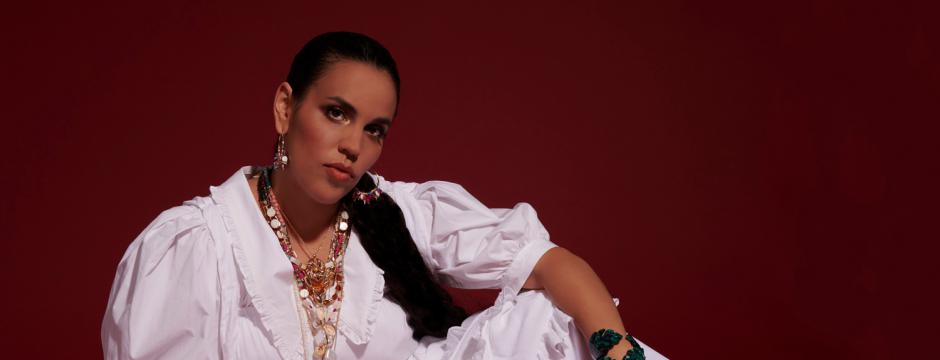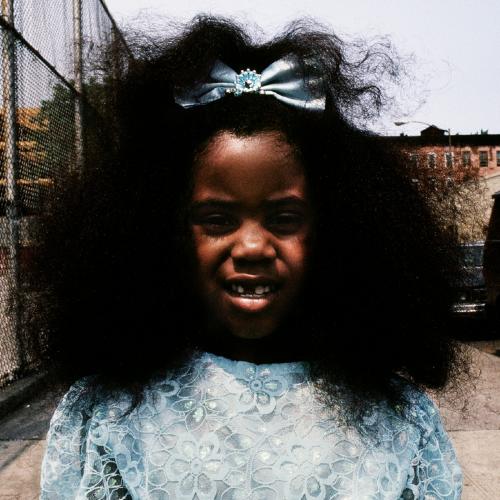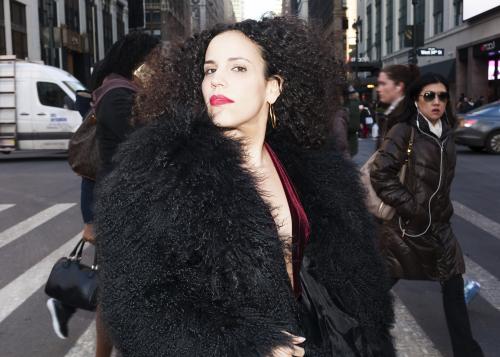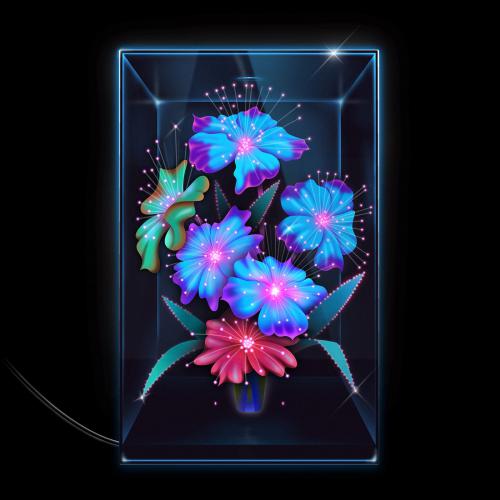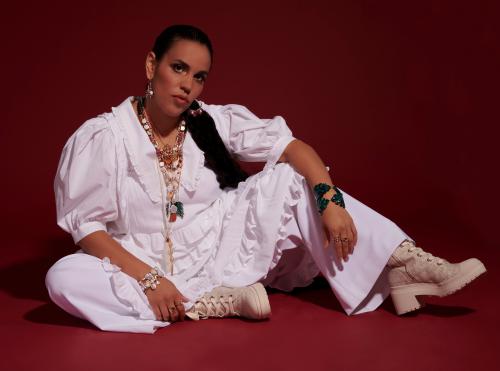Band: Xenia Rubinos
Album: Una Rosa
VÖ: 15.10.2021
Label: Anti-/ Indigo
The song “Una Rosa” has been with Xenia Rubinos all her life. As a little girl, it would emanate from a wind-up music lamp in her abuelita’s room, its fiber optic lights lulling her into a trance with swirling colors. That song—and the lamp that first played it back to her—is the centerpiece of Rubinos’ latest LP -also titled Una Rosa-which comes out on October 15 via ANTI-.
“The image of that lamp carries so much meaning for me,” Xenia says. “It's dreamy, futuristic, nostalgic, melancholy, over the top. It’s the perfect image for the music I’m making right now."
That music is somewhat of a departure from her earlier work, in that it’s very much“in the box”; rather than striving for pitch-perfect vocal takes and tight live instrumentation, she cut most of her vocals in a single take, writing and recording everything right on the spot and refining them after the fact. It’s the most electronic music she’s ever made, yet also the most spontaneous, the product of her “first mind,” the thoughts on the tip of her tongue. It was also the most difficult record for her to make. By November 2019 Xenia had been on the go nonstop since the release of her critically acclaimed 2016 LP Black Terry Cat, touring the world, performing, and promoting her record.
She released the personal superhero anthems "Diosa vs Bugeisha" that month, experimenting with a more electronic palette and character building—themes that would ultimately help shape the cinematic narrative qualities of her own novela, Una Rosa. But her hustle hid heartache, and she reached a point where she wasn’t sure she’d be able to continue making music. She consulted a curandero, who diagnosed her with "perdida de espiritu" (“loss of spirit”). But he also assured her that her days of making music were not over.And it was the music, as well as her longtime collaborator producer and drummer Marco Buccelli, that helped pull her out of the abyss. At the start of the new year, he dragged her to their new studio and patiently supported her as she re-learned how to make music, and re-built herself as a musician from scratch.
As the music she was making coalesced into something more cinematic, the visual story of Una Rosabegan to take shape even before the music was completed, and the song’s music videos and cover art served as reference points while producing the music. Each single came with a portrait of a different character; The rage-fueled, grill-wearing woman and the caged little girl in "Who Shot Ya?", the grieving party girl of “Did My Best,” the fortune-telling futurist jazz singer in "Cógelo Suave." The record would have two sides: The “RED” A side, comprising hot, aggressive, in-your-face fiery drama, and the “BLUE” B side, with more introspective yet expansive mood. Just like her abuela’s flower lamp, it changes colors through the night hours, accompanying you along the journey.In the opening sequence, a clock tower’s bell tolls four, opening a portal to a new world, haunted by the hum of the faintly remembered melody, "Una Rosa." The tragic "Ay Hombre" follows, an ode to the dulcet tones of the cortate las venassingers that floated through her abuela’s home. From there, the record expands outward. Xenia developed characters based on old boleros, and reimagined rumbas for the 21st century.
“Sacude” flips a sparse clave intro into a thumping hip-hop beat. And drawing inspiration from a documentary on las cuatro joyas del ballet Cubano, she made her version of “Una Rosa”—now identified as a José Enrique Pedreira song—into electronic classical composition...with clave. “Don’t Put Me in Red,” a riff on the front-of-house lighting engineers that always give her “latina lighting,” forcefully resists any and everyone who might want to put her in a box.
But while she was previously loath to discuss her ethnicity at the expense of discussing her music, Rubinos acknowledges the cultural environment Una Rosaenters is a different one, freeing her to explore it more. There’s certainly more Spanish on Una Rosathan any of Xenia’s previous records, though it's less something new than a continuation of her musical language.
“I was listening to [the group] Muñequitos de Matanzas, classic rumba from Cuba, and feeling like I wanted to know something about that music,” she says. “I felt something but I didn't understand it...it's my exploration into these sounds I grew up hearing and into this aesthetic—in my own way. I’mnot claiming to be an expert, but this is how I hear it, you know?”
Songs like “Working All The Time” explore and expound on things that she’s previously touched on, like the crushing yolk of capitalism, while “Did My Best” dwells in the aftermath ofsudden loss, longing to see someone you never got to say goodbye to. “I remember the moment when I felt I was done singing, it’s like when you cry so hard you forget why you were crying in the first place,” Rubinos recalls. “As we listened back, the hairs on my arms and legs stood straight up, I felt my face getting hot. I suddenly felt that old familiar feeling. At that moment, in the basement during an eerie quarantine night of fireworks and ambulance sirens, I suddenly remembered why I sing.”
A true expansion of what the world knows Xenia’s palette to be, Una Rosafeatures some of the most complex and cinematic production that she’s done to date. Emotional, vulnerable, and spontaneous, each track on the record keeps the listener anticipating the next turnin a story that reaches backwards in time to create a futuristic sonic space. By the final track "What Is This Voice?" its journey of exploration comes full circle, culminating in a vulnerable, stripped-down meditation on Xenia’s identity and sound.
Band: Xenia Rubinos
Album: Black Terry Cat
VÖ: 03.06.2016
Label: ANTI- / Indigo
Website: www.facebook.com/xeniarubinos
Visionary singer and music maker Xenia Rubinos dips in and out of genre and structure to create movingly powerful songs with her O.G. signature sound. Xenia’s powerhouse vocals are at the center of her music which grows from a wide range of influences from R&B to Hip-Hop to jazz all delivered with a soulful punk aura. Pitchfork lauded the radiant singer as “a unique new pop personality” while a profile in The New Yorker described her work as “rhythmically fierce, vocally generous music that slips through the net of any known genre”.
Xenia grew up in Hartford, CT wailing along to Mariah Carey songs on the car radio. “My mom would drive around the block a couple extra times just so I could finish singing along if my favorite song came on. My parents weren't musicians but both really loved music and encouraged my interest, when I was 4 they got me a piano and by age 8 I was using a karaoke machine to record songs and make mixtapes of stuff off the radio.” Xenia’s middle school crush on a trumpet player lead her to discover jazz when he played her a Miles Davis record. She was awarded a scholarship to attend Berklee College of Music in Boston where she went to study voice inspired by the music of Nina Simone and the romantic spooky drama of singers like Billie Holiday and Judy Garland. “I was supposed to write a horn arrangement for this class. I had no idea what I was doing but I wrote it by singing each of the lines and rhythm section parts. I was completely terrified to have it recorded by the band in class. The only thing the teacher said afterwards was, ‘Wow, you must listen to a lot of Mingus!’ embarrassed I didn’t know who he was talking about, I just nervously nodded and when I got home looked up all of Mingus’ music. I was floored, never heard anything like that. It was so soulful and adventurous, I felt like he could do anything with his music. I wanted to find my own voice so I quit singing and delved into composition. My first band was a big loud mess of horns and percussion instruments. That’s when I met drummer and producer Marco Buccelli who would go on to be my main collaborator for nearly the next decade.”
After a move to New York, Xenia began working her voice into compositions and improvisations. Feeling an urgency to perform new music, she started experimenting with vocal looping and worked up the courage to play keyboards in public. She self-released her debut album “Magic Trix” in 2012. By the following year the album had generated a lot of interest from artists and critics alike and caught the attention of Ba Da Bing! Records who licensed the album for official release in 2013. Xenia went on to tour the US & Europe extensively both as a headliner and support act for such bands as Battles, Deerhoof, Man Man, Coco Rosie and others. Her energetic live show and presence echoes some of the larger than life icons she admired as a child like Nina Simone while her powerful vocals recall the soulfulness of Erykah Badu while wielding a space in music that is utterly her own. “I think my signature sound is a collage of different musics coming together on a visceral level, connecting the dots with my voice and imagination.”
---------
Brooklyn - I was alone outside in the dark cold night looking up at the moon, me down here standing in my own smokey breath and wondering why ANYTHING when out of NOWHERE a giant black scraggly cat sliced through the darkness, jumped up a fence and disappeared so quickly I thought maybe I’d imagined it. Startled, I ran inside and scribbled ‘Black Terry Cat’ on the back of a crumpled up receipt.
Black Terry Cat is a rhythm, it’s a funky flow you can’t quite put your finger on, it’s a magic swagger, it’s leaving super late but somehow making it right on time.
Making this record was a huge life lesson in time being relative and that you can’t rush things, stuff is just gonna take the time it’s gonna take. After touring the US and Europe on my first album, I came back home and spent time with my friends and family, my brown community, boys ladies ladies boys and just started observing this other system, a different way of doing things, another pace. It’s like this magic bravado, swagger that I was in awe of and thinking, wait, is that in me? Making this album was like one huge lesson in how time is relative and things are gonna just take the time they’re going to take, you can’t rush things or force them to happen, they just do and you adjust and live. This album is me contemplating that magic bravado, finding it in myself, trying on different voices I found in there. Not feeling like I have to hide, letting it shine through and actually celebrating my soulfulness.
I wanted to be more candid and intentional in my lyric writing. It was a huge challenge for me but I kept asking myself what I want to say and what I really mean with each word I wrote. Through that process, I got to express some feelings about being a person of color in America and also just some raw feelings of wonder and love. It’s nerve wracking to say what’s on your mind but I just went for it. The general aesthetic for the album was playing with my spin on “ghetto fabulous” or “rough elegance”. How to make something elegant in my own real way.
While making this record I was digging into the music of J Dilla, KRS One, Digable Planets, Rufus, Erykah Badu, immersing myself in Hip-Hop, soul and funk. I think this record is my own personal take on those influences. I wrote a lot of this record on bass, which I don’t know how to play. On the last record I got really chummy with my keyboard, not that I know how to play that either, but I feel I can get too used to certain patterns so I thought picking up an instrument that was completely unfamiliar would force me to just focus on singing and listen to ideas as they came. I learned that the bass is usually what makes me dance, I always thought it was the drums but it’s actually the bass that brings that bounce to the beat. If you nudge the bass just a little bit this way or that way to try to make things “perfect”, the whole house falls down. The only way you get that heavy groove is if you let everything occupy it’s own space and time, that’s when you get everything moving together like this beautiful scraggly, elegant cat. Perfection is anything but
My teammates on this journey were my longtime drummer Marco Buccelli, who produced the album, he really saw my vision through sonically and Jeremy Loucas engineered. The 3 of us worked an average of 16-17 hours a day for about 5 months. I’d show up to the studio and Marco and Jeremy would be there working on a snare sound or agonizing over the trillion options of how to mic something and I’d just start getting into it with them. They both have an insanely dedicated work ethic, they just never stop until they’ve exhausted all possible options. I’m pretty sure Jeremy never pees, he’s like Marina Abramovic in the studio or something, he’ll just sit there for 8 hours straight without distraction and be totally focused. Marco is very much the same way and the two of them really feed each other to become this unstoppable machine that just sucks you in. It was nearly impossible to not be present with them each day in the work. When I didn’t believe in myself or felt like giving up, they wouldn’t let me. Even when we were fighting about something it was all with love and passion. I wish every day of my life could be filled with that much intention. I’m trying my best to keep that same focus and drive in everything that I do on this album. Trying to give all of myself, to take my time, every single day.
